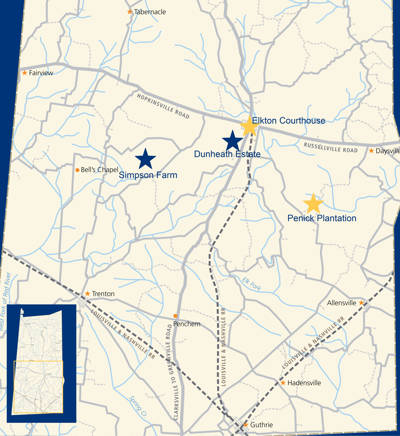

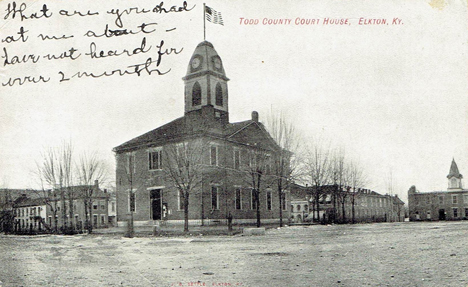
Postcard showing Elkton Courthouse, built in 1835, out the front of which black men voted for the first time on April 25, 1870.
CourtHouseHistory.com; c1872+.
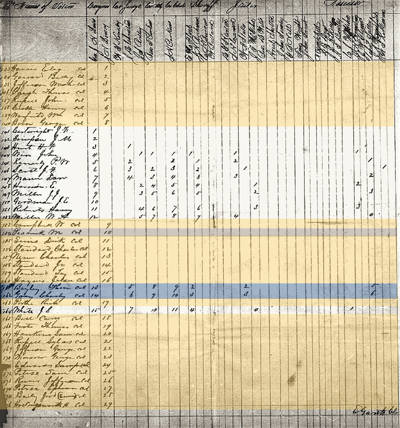
A page from the April 1870 Elton pollbook showing Moses Penick’s vote (highlighted in brown). Other black voters are highlighted, including Democratic voters, Thomas Bailey and Charles Gray.
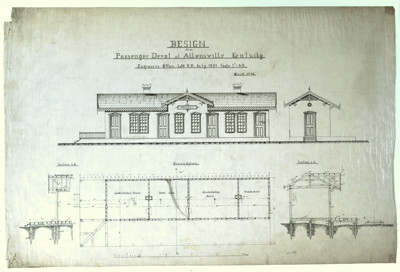
A drawing showing the design of the Allensville train depot built in 1881. In April 1870, Allensville voters would have voted on the platform out the front of its predecessor, a smaller, less permanent structure.
circa 1881; courtesy of the Filson Historical Society (Mss_AR_L888_80).

A page from the April 1870 Allensville pollbook showing Aaron and Jacob Penick (highlighted in blue), formerly enslaved by the father of Garland Penick (highlighted in yellow). Isaac Penick, Garland’s brother, appears at the top of the next page. Both Aaron and Jacob voted Republican; Garland and Isaac voted Democratic.
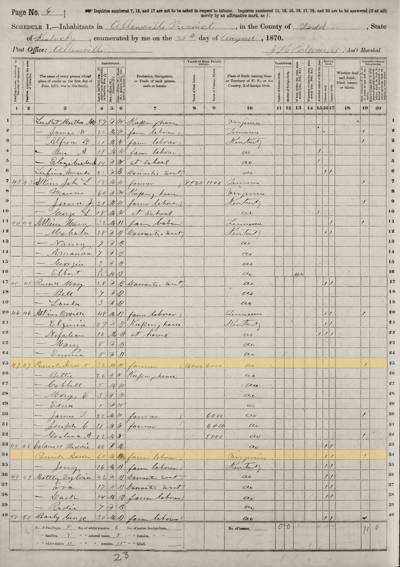
A page from the 1870 U.S. Census for Allensville, showing Aaron Penick living next door to Isaac Penick (likely in a former slave house on Isaac's property). Isaac is Garland's brother, and both are sons of Aaron's former enslaver, Nathan.
Black Men Stand up to Power
Voting Republican in front of White Landlords, Employers, and Former Enslavers in Elkton
In the early morning light, the polls opened on the April 25, 1870, for a special congressional election in Todd County. Elections were a regular occurrence across Kentucky, with at least two every year; but this one was different. It was a special special election. Taking place less than a month after the 15th Amendment [link] became a part of the U.S. constitution, this was the first election in a former slave state in which black men could vote.
At the Elkton Courthouse, a grand public building at the center of town, Moses Penick stepped forward to vote. He declared aloud his vote for the Republican candidate for Congress, John H. Lowry.
Moses declared his voted before and to the most important election official of the day: Egbert Garth, the election clerk, who was creating the pollbook for the day. The pollbook was the official record of the election. In his pollbook, Egbert wrote the name of each of the 634 men who came forward to vote that day, 44 per page, and then each voter’s choice for each office.
Garth was 39, wealthy (with an estate worth $4,500), and a grocery store owner. His family property, “Dunheath Estate” was a grand estate, the oldest house in the Elkton area. He was also Moses’ neighbor, separated by just one household in the census taken that summer. Moses likely lived in a former slave house on the property or on its outskirts.
Garth duly recorded his neighbor’s name, his Republican vote, and, to make sure race was a part of this official document, added that Moses was a black man (using the designation “col”).
At the end of the day, as the last voter, Garth recorded his own vote for the Democratic Party.
Voting with Neighbors
Early in the day, black men dominated voting at Elkton, making up 71 of the first 100 voters of the day.
The black men who lived in the area around Moses were especially politically engaged: Penick’s (and Garth’s) close neighbor, William Russell, was the first black voter of the day. A 25-year-old plasterer, Russell was the 12th voter of the day and only the second Republican. He voted on his own, between numerous white Democrat voters.
Moses voted later that morning. He was the second voter in one of the largest black voting blocs of the day: 29 newly enfranchised African American men, many of them neighbors, interrupted by only two white men. The men with whom Moses lined up were next-door neighbors. Richard Simms, Jesse Haynes, and three brothers and/or former plantation cohabitants, Charles, Joseph, and Taylor Standard lived together near white farmer Peyton Simpson’s property, less than a mile west of the Garth land near which Penick lived.
Another pair in the group must have caused a stir among the gathered crowd around the courthouse. Not because they were black — over 100 black men had already voted at the courthouse that day by the time they arrived — but because of the way they voted.
Two of the group, Thomas Bailey and Charles Gray, declared their votes for the Democratic Party candidate for Congress, Confederate General Joseph H. Lewis.
It was unusual for black men to vote Democrat: just one other of the 244 black men who attended the polls in Elkton that day did so. So two black men voting Democrat consecutively must have been unexpected. It likely also caused some consternation among other black men, given the party had defended slavery.
Surprise or not, these were not once off votes. Bailey and Gray reaffirmed their support for Lewis in the regular congressional election in November that year. They were the only two black men in all of Elkton precinct to vote for Lewis over his Republican opponent, Dulaney R. Carr, in November 1870.
One of the most remarkable features of the April 1870 election was the inclusion of a primary election to nominate Democratic candidates for the county election later that year. In return for their vote for Lewis, Bailey and Gray were able to vote in the Democratic primary to nominate Democratic candidates, something no Republican voter did.
Voting among Former Enslavers
In making his way through the assembled crowd and to the voting platform, Moses Penick, like all African American men voting on that April 1870 day, was voting in the presence of and within earshot of powerful white men who had resisted his humanity: men who had owned him and his friends, men who had fought for the Confederacy, and men who were involved in the Ku Klux Klan.
James T. Penick, the son of Moses’ deceased enslaver, Nathan, rode into Elkton from the family plantation on the Allensville road, five miles out of town. He voted a few hours after Moses. James T. was a prominent Democrat around town and would be elected county tax assessor in 1878 (and re-elected in 1882 for another four years). He declared an opposite vote to Moses: for the Democrat Lewis.
Given that elections were large public events where spectators loitered for hours eating and drinking, it is possible that James T. witnessed Moses’ vote (and vice versa). Certainly, it must have been in Moses’ mind that members of the family who enslaved him and put him to work in their tobacco fields were likely present in the crowd. It must have also occurred to Moses that they might react poorly to his vote for the Republican candidate and that his vote could have consequences for his job prospects (as a farm laborer), living situation, and safety. And not just consequences for himself: Mosses and America Penick, had four children, ages 11, 4, 2 and two months.
The Penicks in Allensville
The Penicks were one of the wealthiest families in Todd County. In 1860, Nathan Penick’s plantation on the Allensville road produced 38,000 pounds of tobacco and covered 600 acres. The cash value of the plantation was $24,000. He owned 30 people, making him one of the largest enslavers of black people in the county. The slaves lived in five slave cabins on the tobacco plantation.
Nathan Penick died in April 1864. His four sons inherited his estate. In 1870, Isaac (the eldest), James T., Joseph C. and Garland A. had estates totaling $39,000.
Unlike James, Isaac and Garland voted in the village of Allensville, five miles to the south of Elkton. As might be expected of young white men from a wealthy tobacco family, they too voted Democratic.
In Allensville, the election was held on the platform of the train depot. There, both Garland and Isaac almost undoubtedly witnessed two former slaves of their family, Aaron and Jacob Penick, vote for Lowry. Only four voters declared their vote between Aaron and Garland, and only another nine between Garland and Jacob. In 1870, Aaron still lived on Isaac’s land and was his closest neighbor. He likely still worked for Isaac on the tobacco farm. Yet he publicly and audibly stood up and voted against his former enslaver, current landlord, and current employer’s political party, declaring his vote for Lowry.
Voting among Current Employers and Landlords
Russell, Penick, and the Standards lived among very powerful white men. The most powerful person in Todd County, James D. Christian, the County Judge (the chief executive), lived just four families away from Penick. Benjamin Thomas Perkins, Clerk of the Todd County Court and the Circuit Court, lived just one family farther away with his sons, the Deputy Clerk and another a lawyer. They were all Democrats.
Then there was Egbert Garth, the clerk for the election who witnessed and chronicled in his pollbook every vote that day. Egbert was a Democrat and had been raised on his family’s tobacco plantation in the Fairview district. In 1860, the plantation of 300 acres raised and sold 11,000 pounds of tobacco, produced by ten slaves.
Pascal Lee Garth, Egbert’s father, died in 1870, a few months before the census taker came calling. His mother, Lucy, lived at Dunheath with her eldest son, Garth, and two of her other sons. Egbert and his mother now jointly owned and ran the plantation over in Fairview, which was a smaller enterprise than its antebellum enslaved-labor-fueled heyday.
Moses was still a farm laborer in 1870 and there is every chance that he labored for his neighbors, the Garths, still cultivating tobacco as he had as nameless property. For Moses, like all other black men, in Todd County, whether in towns or in the countryside, turning out to vote inevitably meant standing up to powerful white men – and white women -- who had been enslavers only a few years before.
High Turnout and Divided by Race
The presence of witnesses hostile to their Republican vote and the potential consequences for their employment and housing prospects, did not dissuade the black men of Elkton precinct from exercising their newly won franchise. In Elkton, we estimate that 73% of eligible black men declared a vote (compared to 62% of white men) in the April 1870 election.
In total, 224 (35%) of the 635 voters at Elkton that day were black. They voted overwhelmingly (221 to 3) for the Republican candidate for Congress, Lowry.
The former enslavers of these new black voters made up a large part of the remainder of the electorate. Of the 411 white men who turned out to vote at the Elkton Courthouse, 71 (28%) of those white voters who were old enough to own slaves in 1860 had done so according to the 1860 Census slave schedule. All but six (95%) voted for the Democratic candidate, Lewis.
Many more white voters came from formerly slave owning families. In total 350 of the 411 white voters (85%) voted Democratic. Indeed, more white men attended the poll but abstained from voting for a congressional candidate (9%) than voted Republican (6%).
Across the county, this pattern repeated. The vote was split along racial lines: 96% of black voters voted for Lowry (R); 94% of white voters voted for Lewis (D). This would prove to be the central failing of the Republican Party across Todd County: It was unable to turn out those white men who had voted Republican before 1870. Of the 156 white men who voted Republican in 1868 or 1869, only 50 voted Republican in April 1870 and only 55 in November 1870.
A Lower Turnout Re-run in November
Lewis’ victory in April only assured him the remainder of Jacob Golladay’s term, which had only 8 months to run. That meant that, on Tuesday November 8th, 1870, Lewis was once again up for election. This time, Dulaney R. Carr, a Tennessee-born lawyer and second lieutenant in the Union Army, was his Republican opponent.
After the uncompetitive special election in which the Democratic Party showed that, even with the new additions to the electorate, it still controlled Todd County, turnout plummeted. This turnout decline was especially pronounced among white voters, perhaps because many were no longer worried that the Republicans could ride to power on the black vote.
Of the 635 men who voted in Elkton in April, just over half (358) returned to the polls to vote in November. They were joined by only 86 new voters. Black turnout dropped from 73% to 61%; by contrast, white turnout dropped from 62% to 39%!
Most of the black men Moses Penick voted with in April returned in November, although they did not vote together. Only two members of the group of 11 were absent (Charles New and W. Campbell). All the Standard brothers made their way back to the courthouse. All returned voters voted the same way: Bailey and Gray cast the only two black votes for Lewis, while Penick and the Standard brothers and the rest voted for the Republican, Carr.
In November 1874, Penick, two of the Standard brothers, as well as their neighbors Richard Simms and Jesse Haynes, once again voted in the congressional contest. This time we do not know for sure how they voted, because in 1871 Congress prohibited the use of viva voce for congressional elections.


